Women's monthly magazines:
19 to Cosmopolitan
This page carries profiles of women's monthly magazines, many of which are known as glossies (in the UK) or slicks (in the US) because of their high production values and upmarket editorial. Some weeklies – such as Grazia and Riva – are included because of their attempts to establish themselves as weekly glossies. The main index page for the women's magazines is here. The titles – past and present – are arranged alphabetically on the following pages:
- 19 to Cosmopolitan [this page]
- Easy Living to Grazia
- Harper's Bazaar to Mirabella
- New Woman to Over 21
- Queen to Riva
- She to Zest
- Table of top 5 sellers
- Key facts on women's monthlies
Main women's monthly index page.
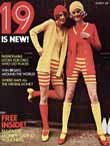 19 –
first issue cover March 1968
19 –
first issue cover March 1968
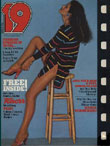 19
– women's magazine aimed at a younger reader that was victim of
changing trends in teen reading
19
– women's magazine aimed at a younger reader that was victim of
changing trends in teen reading
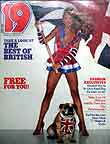 19 magazine bulldog cover
19 magazine bulldog cover |
19 [closed]IPC SouthBank, monthly, March 1968 – May 2004Young women’s glossy aimed at 16- to 19-year-olds. The established magazines in this sector all steadily lost sales after 1980. 19 was the last survivor of the big three IPC titles. Honey merged with 19 in 1986 after circulation almost halved in five years; a similar fate befell Look Now in 1988. These mergers helped 19, but its sales were still down by about a fifth in 1990 over the decade. When it finally closed, IPC said: 'Over the last few years, the face of the teenage market has changed. The boundaries between the teen market sub-sectors have become blurred and sales patterns suggest that readership at the older, young women’s end appears to have migrated to the fashion and celebrity markets.' Final editor was Helen Bazuaye. The publisher launched Teen Now, a spin-off from its celebrity weekly Now in spring that year and in March Emap had closed The Face and J-17 (Just 17). IPC profileTeen sector in distress |
 Aura – women's magazine aimed at those in their 'Jaffa Cake' years by Eve Pollard |
Aura [closed]Parkhill, monthly, May 2000-2001Launched by former Sunday Express editor Eve Pollard as a mature women's magazine - for women in their 'Jaffa Cake' years ('the juiciest bits in the centre of our lives'). As the launch issue said: 'We were the ones who read Honey, wore loons and Biba T-shirts, screamed at the Monkees, had the Che Guevera poster ... We were groovy. We still are.' Faced extensive competition from other launches, including IPC's revival of Nova, Hachette/Emap's Red and BBC's (now Haymarket's) Eve. Tim Holmes in his Magblog has suggested that it was unfocused and 'a newspaper person's idea of a magazine'. One of Pollard's first jobs was on Honey in 1962. Parkhill profile |
 Kylie Minogue on the cover of the first issue of the UK edition of Australian Women's Weekly in November 2001 |
Australian Women's WeeklyACP, monthly, November 2001 – ?Short-lived UK version of the popular Australian woman's monthly (despite the name!). Rather than push ahead with the title, ACP formed a joint company in 2004 with National Magazine to publish weeklies. ACP-NatMags profile |
 First issue of B in June 1997 |
BAttic Futura/Hachette Filipacchi UK, monthly, 1997 – March 2006 |
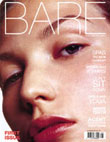 First issue cover of Bare – such a tight focus on a face is unusual and usually regarded as not being attractive to buyers |
Bare [closed]John Brown Publishing, six issues a year, Sep/Oct 2000-May/Jun 01Focused on 'well-being' as a lifestyle choice. In January 2001, the magazine caused controversy by claiming Welsh people smelt of cabbages because of their diet. It was reported as selling about 60,000 copies every two months, but closed after just five issues. Editor Ilse Crawford had launched Elle Deco in 1989. The publisher was Honor Riley. John Brown profile |
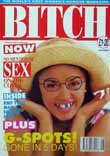 First issue cover of Bitch |
Bitch [closed]Bitch Publications, Hove, East Sussex. Sep 1992-? |
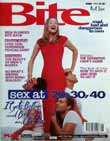 First issue cover of Bite from Ann Summers in June 1993 |
Bite [closed]Ann Summers Ltd; £1.95; 100 pages. Ed: Catherine Handcock. Jun 1993-?Expansion into magazines by the sex catalogue and shop chain Ann Summers. Main cover line: 'Sex at 20, 30, 40. It gets better and better and better.' Its selling line was: 'Mad, bad and dangerous to own.' |
 First issue cover of Britannia and Eve in 1929  One of the last issues, in 1956, of Britannia and Eve |
Britannia and Eve [closed]British National Newspapers, 346 Strand, London. Printed WH Smith, Arden Press, Stamford St. 1s.Monthly women's magazine created by the merger of two weeklies – Eve, a women's society weekly glossy, and Britannia, a current affairs weekly launched just the previous year. Although the title was never actually changed, the emphasis on the two elements of Britannia and Eve changed over time to favour the latter in its final two years. |
Celebrity Looks [closed]New name for Emap's Looks in May 2001. However, the 20-year-old title closed less than a year later. |
Chic [closed]The Voice Ltd, monthly, 1985-[not known]Launched at the end of 1985 as Britain’s first black women's glossy. Chic was set up by Val McCalla, who had founded The Voice newspaper during London's Notting Hill Carnival in 1982. The first issues came out as a supplement to The Voice. Chic claimed a circulation of 32,000 at one stage. The editor, Winsome Cornish, was quoted in the Guardian (3 June 1986) as saying that there was a big problem in attracting and combating mono-racial attitudes in the advertising world, but that more agencies were showing an awareness of advertising for black markets. |
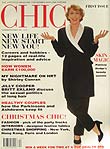 First issue of Chic with actress Patricia Routledge on the cover 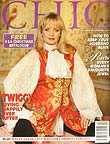 Chic cover with Twiggy in 1996 |
Chic [closed]Hamerville/Northern & Shell, monthly, November/December 1993 – July 1998Launched by Hamerville Magazines, Watford, as a bi-monthly lifestyle title for women aged 40-55. Former Cosmopolitan editor Joyce Hopkirk was the editor. The cover price was £1.70 and the first issue had a print run of 200,000, aiming for a settle-down circulation of 120,000. Its strapline was: 'For women who can choose'. The first issue carried an interview with Eve Pollard, then editor of the Daily Express. At the time, advertising agencies raised doubts about the title’s bi-monthly frequency. In 1995, it was bought by OK! publisher Northern & Shell. It
was relaunched and went monthly under editor Ruth Corbett in May
1998. Pollard, who had since left the Express, was then appointed
editor-in-chief. However, in July, Northern & Shell closed the
magazine (plus six of its adult titles) blaming unreasonable terms
set by wholesaler W H Smith News. Pollard went on to launch her
own short-lived magazine for a similar market, Aura,
in May 2000. |
 First issue cover of the BBC's Clothes Show magazine with former ITV News at Ten newsreader and 'Queen of Breakfast TV' Selina Scott on the cover – she presented the BBC TV Clothes Show series with Jeff Banks. The cover photograph was by Terry O'Neill |
[BBC] Clothes Show [closed]Focus Magazines / BBC Enterprises. Spring 1988- December 1997First of the modern BBC-related launches. Originally, this style magazine was licensed by the BBC to a small London publisher, Focus Publishing, run by Richard Hease (who had set up the joint-venture Micronet with British Telecom in 1983). The magazine was based on the TV series of the same name fronted by Jeff Banks and Selina Scott, and focused on 16-to 24-year-olds. The aim was to make fashion more accessible and the series had began in 1986. There was a spring issue in 1988, a summer issue (out in May) as the TV series came to the end of its run, but the title was monthly from October, coinciding with the start of the next Clothes Show series. The editor was Roy Kent with Karen Foster as fashion editor. In 1990, Focus folded, but it had shown the way for the BBC. The title was taken over and revamped by BBC/Redwood, but never fully accepted as a BBC brand. When it closed, Clothes Show was seen as struggling to compete against Looks, 19 and Sugar, selling 150,494 copies a month, a figure down nearly 3% on the previous year. The publisher felt too much money would have had to be invested to hold that circulation. Sugar's sales had increased 31% to 474,104. |
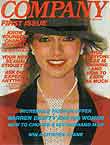 Company – the first issue cover of October 1978 with features on Jenny Agutter and Warren Beatty  Company cut its cover price for the November 2001 issue to £1.50 |
Company [closed]Hearst/National Magazine Company, monthly, October 1978-2014Company was closed by Hearst UK, with the last issue being dated October 2014. It started out as a title aimed at university-educated women in their mid-20s starting their career and before having children. Stated 'brand values' were: Sexy; Sassy; Sorted; Fashionable; Fun; On Your Side; British. The NatMags website said the original concept was for a unisex magazine, called Two’s Company. Several dummies were produced but there were doubts about attracting enough advertisers and the concept was developed into a magazine for the ‘post-liberated girl’. A launch marketing budget was set at £450,000 – five times more than was spent on Cosmo – with the slogan ‘The new magazine for girls who like a lot of action between the covers.’ The website says the first television advertising campaign was censored by the Independent Broadcasting Authority, which insisted on the removal of a scene in which a sexy woman driver called to three male hitch-hikers, ‘How far do you want to go?’ Editors include: Gill Hudson; Mandi Norwood National Magazines profile |
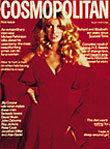 Cosmopolitan – the first issue dated March 1972 costing 20p. A clever blend of cover lines and image helped make it the best-seller in the UK, a crown it lost for a while with the arrival of the handbag-sized £1Glamour in 2004, but regained |
CosmopolitanHearst UK / The National Magazine Company (owned by Hearst in US), monthly, 1972-The British edition was the first international version of a US title that had been around since 1886 but was reformulated by Helen Gurley Brown (author of Sex and the Single Girl) to great success in 1965 for the new, 'liberated' woman. The 1972 launch editor in UK was Joyce Hopkirk, former woman's editor at the Sun (Deirdre McSharry who took over as editor later in the year also came from the paper). Saatchi & Saatchi did a TV commercial and the first print run of 350,000 sold out. The second issue featured a male nude (Paul de Feu, Germaine Greer's husband). Cosmo's arrival led to the closure of NatMags' Vanity Fair and killed off Nova. Cosmopolitan became the world's best-selling woman's monthly – and best seller in the UK until the arrival of Glamour in 2002. Spin-off titles include Cosmopolitan Man (just one issue) in April 1978; Zest in 1994; Cosmo Hair, Cosmo Girl! and Cosmopolitan Real Life Stories in 1999. The name has been licensed for wide variety of goods, including exhibitions, cafes, cars and yoghurt. In 1989, Hearst Magazines International was founded by US parent
to exploit brands such as Cosmopolitan. In 2004, Hearst
launched 50th international edition of Cosmo – in Bulgaria.
In Indonesia, the title became Kosmopolitan, because the
Indonesians pronounce 'c' as 'ch'. |


